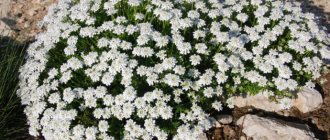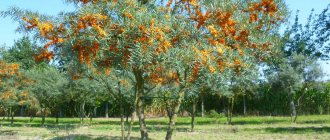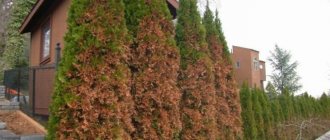- Updated: November 4, 2020
What to plant in the garden is the main question asked not only by beginners in farming, but also by experienced summer residents who have been reaping a good harvest for many years. There is so much I want to grow! There are a huge number of seeds of different garden crops in stores, and even more varieties of them. My eyes are wide open. And in order not to buy too much, it’s worth thinking through everything carefully. And this needs to be done as early as possible. After all, some crops will have to be sown as seedlings, which means that the list must be compiled by the end of February. Unless, of course, you plan to buy ready-made seedlings. Then everything is a little simpler.
Five questions that make a big difference
An experienced summer resident may no longer answer them, but a beginner should think about it. There are only five answers that will make choosing plants much easier and will tell you what you can plant in your garden.
- Family preferences. What vegetables and berries do family members, including children, like? You can conduct a survey. It will allow you to quickly navigate the candidates for seeding.
- Purpose of cultivation . Seasonal use or preparation for the winter. The volume of plantings depends on this.
- Possibility of crop care. How often will the garden receive attention - every day or only on weekends?
- Illumination of the area . Not all vegetables can grow in the shade of trees, especially conifers.
- Climatic conditions. First of all, you need to pay attention to whether the planted crops will have time to fully ripen.
You can answer them with the whole family. This is another reason to while away the long winter evenings in a friendly company, and at the same time decide what vegetables to plant in the garden.
What should grow in the garden
Rarely does a garden exist without fruit trees. Most often this is an apple tree, which can grow in almost any climatic conditions. A variety of berry bushes perform a variety of functions here. They can serve as a living fence (rose hips, hawthorn), provide a harvest of tasty and healthy berries (currants, gooseberries, raspberries, etc.), which are used in homemade preparations. In addition, during the flowering period, many shrub plants also play a decorative role.
A real decoration of the garden will be the vineyard, which can also be an architectural structure. Instead, hops are also planted as hedges. Decorative flowers, both perennial and annual, are the most popular plants in gardens. Miniature inflorescences of violets and marigolds, large luxurious peonies, gladioli and roses can delight with their beauty throughout the entire summer season. Fragrant and bright flower beds and flower beds are an essential attribute of any garden.
Planting plan
The plan begins when a list of vegetables has been compiled. You can, of course, quickly sketch everything out on your knees. But it is better to approach the construction of the plan more thoroughly - with the help of graph paper. To do this, you will have to arm yourself with a tape measure and measure the area, including all buildings, flower beds and the vineyard. Transfer the obtained data to graph paper, and from it to tracing paper (or photocopy).
After such preparation, zones should be correctly marked on one of the copies depending on the illumination. You may have to spend a day on this to observe the movement of the sun and the intensity of illumination of the area. The water source must also be marked on the plan. There are crops that benefit from rain, such as corn and beans, but most require supplemental watering.
If you plan to build a greenhouse or greenhouse, this place should be noted. Then lay the paths. In this case, you need to take into account the passages for the wheelbarrow; they should be at least half a meter, or even more. If it is not available and is not expected, space can be saved by laying paths of 30 cm. And only after that start planning the beds.
How many beds are needed? How to make the perfect garden bed
In order for the dacha to bring not only benefits, but also to please with beautiful and easy-to-cultivate beds and smooth paths, the gardener needs inexpensive and high-quality material for making beds. Moreover, it is desirable that such beds also contribute to increased productivity.
Spring for all summer residents and gardeners begins the same way: dig up all the soil, divide it into beds, make a neat earthen roll for each. Then wait until the soil warms up, plant the plants and begin fighting weeds that occupy the entire area, including paths. But improvements can be made that will help produce a larger harvest at lower costs (labor, first of all).
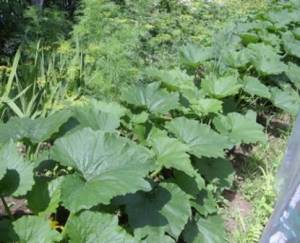
Beds help us a lot when cultivating vegetable crops in greenhouses and vegetable gardens. The fencing of the bed (sides) does not allow the plant soil to crumble and maintains the required shape of the bed.
And if they are arranged correctly, the yield will also increase.
Dimensions of garden beds
Width of beds
First, about the width of the beds. If there is an approach to the bed from two sides, then its width can be from 70 to 100 cm. Making a bed less than 70 cm is not economically profitable, because the narrower the bed, the higher the cost of arranging 1 square meter. m beds. It is not advisable to create beds wider than 100 cm, because it is inconvenient to cultivate the middle of the bed (it stretches far). Beds that can only be approached from one side should have a width of 50-60 cm. Correctly selected bed width will contribute to better tillage, weeding, and, accordingly, increased yield.
Width of passages between beds
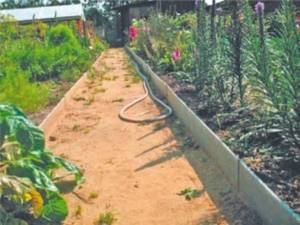
The passages between the beds should allow you to move freely along them with tools and mow them with trimmers. The minimum is about 45 cm. The width of the passages depends on the height of the beds. The minimum width is permissible for beds up to 20 cm in height. With higher sides of the beds, passages should be 50 cm or more. After all, we constantly walk between the beds with buckets and watering cans, and in the narrow passage between the high beds we will have to lift the buckets over the sides and carry them on outstretched arms. Correctly selected width of passages between the beds will contribute to better processing, which, in turn, will lead to increased yields.
Height of beds
The most common height of beds is about 15-20 cm. It would be great, of course, to have beds 70-80 cm high and process them while standing, but this will require a lot of labor. But a very realistic height of 30-40 cm will allow you to care for plants while sitting on a stool or, for example, on a folding chair, which can be very important for older gardeners. Such high beds are usually arranged with a heating bottom layer. In addition to the opportunity to prepare a kind of nutritious “pie” in such a bed, which is extremely beneficial for plants, high beds are easier to process, which will also lead to increased productivity.
Length of beds
The length of the beds can be very different. It is determined by the configuration of the site, its topography and other reasons. Most often, the length of the beds is from 4 to 8 meters. It is better if the bed is oriented from south to north, then the sunlight will illuminate the plants more evenly.
Longitudinal slope of beds
It will be ideal if there is no slope of the bed in the transverse and longitudinal directions. In any case, this is what we should strive for. The permissible slope is 2-3 cm per 1 meter. With a greater slope, water will flow down the slope when watering, and the plants at the bottom of the bed will receive more moisture. But this is not always possible due to the topography of the site. Then we place the beds across the slope of the terrain and plan the area with terraces.
Fencing material for garden beds
The materials for the sides must be durable, since the sides are subject to heavy loads. Materials must be resistant to water, sun, frost, bacteria, mold and insects. They should last a long time and not be very expensive. A variety of materials are used, but we will look at the most common ones - wooden boards and flat slate.
The main inhabitants of the beds: a sample list of vegetables for planting in the garden
The main vegetable, both on the table and in the garden beds, is potatoes. The lion's share of the plot is allocated for it. But what to plant in the garden on the rest of the territory is not an easy question. The most common vegetables that can most often be found in the country are:
- tomatoes;
- pepper;
- cucumbers;
- carrot;
- onion;
- beet;
- eggplant;
- green beans;
- cabbage;
- zucchini.
The list should be supplemented with garlic, herbs (dill, parsley, basil), perennial plants (sorrel, horseradish) and early cold-resistant vegetables (radish, lettuce).
Plants for beginner gardeners
First of all, you should take into account that flowers are classified not only by variety, but also by life expectancy.
Annuals are plants that go through their entire life cycle in one season. This also includes biennials that bloom in the second year after planting. If you choose specimens from these groups, you should be prepared for the fact that they will have to be replanted every season.
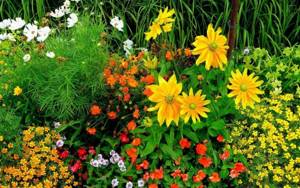
But you can plan their location in the flower garden in advance, not think about how they will winter, and form new flower arrangements on your site every year.
Annuals include: nasturtium, petunia, marigolds, begonia, salvia, calendula, snapdragon. The combination of these plants will allow you to create magnificent floral ensembles every year.
If you don’t have the time and desire to constantly change the composition of your flowerbed, then you should focus on perennials. Having taken root once, they will delight the eye with their flowering for more than one season. The most popular representatives of this group: peonies, dahlias, pansies, bergenia, alyssum, geranium, gypsophila, irises, daylily.
Which flowers to plant in the dacha - perennials or annuals - is an individual choice for everyone, which depends on personal preferences and capabilities.
Vegetables that start every new season
These are, of course, radishes and lettuce. The very first vegetables. The bed for them can be prepared in the fall, and as soon as the ground warms up a little, sow immediately.
However, we are not the only ones who have missed juicy vegetables over the winter. The cruciferous flea beetle is in a hurry to feast on tender greenery. After all, radishes are the very first to sprout, when there is nothing else in the garden, except maybe a couple of frail weeds. It happens that a flea beetle can destroy all crops overnight, and not just make the leaves lacy.
But there is a way out. And this is leaf lettuce. It repels the pest. Therefore, when sowing, it is necessary to alternate rows of radishes and lettuce. In addition, this leafy vegetable can be sown in the fall and simply planted in orderly rows in the spring. During the season, several harvests of radishes and lettuce are obtained, which is very profitable. The main thing is to choose suitable varieties that are resistant to bolting.
Plant selection
The next important criterion is the flowering period. The decorativeness of the flower bed depends on it. What flowers should I plant to create the impression of continuous flowering of plants on the site?
In early spring, already in April, bulbous representatives of the flora bloom - tulips, irises, muscari, crocuses, lilies of the valley. In May, daisies, phlox, forget-me-nots, and primroses take up the baton.
With the onset of summer, marigolds, bluebells, begonias, and dicentra bloom. In July - astilbe, lavender, verbena, clarkias, ageratum, zinnias. By August - chrysanthemums, dahlias, cyclamen, canna, goldenrod. Many of the summer flowers will delight you with their decorative properties until the frosts.
And finally, autumn flowers - asters, colchicum, rhododendron, impatiens.
When wondering what flowers to plant in a flowerbed, one cannot ignore how tall the adult plant will be.

If you need low representatives, then it is recommended to pay attention to astilbe, periwinkle, alyssum, saxifrage, some types of phlox, primrose, and sedum. The average height is for cornflower, gypsophila, daylily, heuchera, peony, lupine, and cornflower. Tall plants create a good background for their shorter counterparts. Among them, the most popular among gardeners are delphiniums, cornflowers, buzulniks, heliopsis, goldenrod, and meadowsweet.
It is simply impossible to list the entire existing range. It is very large, and new varieties and hybrids appear all the time. Therefore, we will focus only on the most popular color names. And what plants you can plant in your dacha, you decide for yourself.
Greenery: nothing without it
Planting vegetables in the garden will be incomplete without herbs. And there are a lot of them. And each has its own secrets.
- Dill. It may take a long time to rise. The reason is the high percentage of essential oils. Its seeds can be soaked before sowing or simply scattered around the garden. This plant, like other herbs, repels many pests, and at the same time improves the taste of vegetables.
- Parsley. The problems with germination are the same. Before sowing, you should decide on the type of plant, since parsley can be leaf or root. The main secret of the plant is to repel slugs. Therefore, it is often sown as a barrier around strawberries, which these pests love so much.
- Basil . Almost universal seasoning. And a very original plant. In spring it can be planted through seedlings or simply sown in open ground. It acts similarly to dill. However, it has one advantage - propagation by cuttings. It is enough to cut off the shoot and put it in water. In a few days the first roots will appear. Next - planting in the ground or in a pot. By the way, in this way you can provide yourself with greens in the winter - just root the cuttings in a flower pot. And you don't have to wait for the seeds to sprout.
But fennel is a rather capricious plant, and also terribly uncooperative. Not only should it grow separately from everyone else, but also avoid proximity to tomatoes, beans, and even its fellow dill.
How many fruit trees to plant on the plot. Where to locate the orchard
Growing a garden is not easy. The main mistake of novice gardeners is that they rush to develop the site without studying the planting culture. Over time, seedlings planted without taking into account their characteristics and compatibility begin to become infected with diseases and oppress each other. Proper placement of fruit trees in the garden, taking into account sunny and shady areas, soil types, and the depth of groundwater is the key to a future successful garden.
Nature itself helps determine the suitability and unsuitability of land for gardening. Maple, rowan, and wild pear grow on richer soils, alder, willow, and sedge grow in wetlands. Dense clay and rocky soil is not suitable for planting a garden. The ideal option is chernozem, but more often plants are planted on moderately acidic soils. The main thing is to do this away from conifers and birches, in an area cleared of fallen leaves.
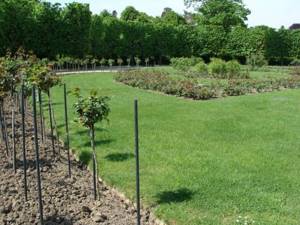
In areas with high groundwater, plants also cannot develop well, since the roots will constantly be in water and rot from lack of oxygen and nutrients. The optimal water level for fruit trees should be no closer than 15 m from the surface. But for shrubs (gooseberries, currants and raspberries) the water can be 1 m away and not harm the plants.
There are no trifles in organizing gardening. Listen to the opinions and advice of experienced gardeners and gardeners. Decide your preferences in advance. There is no need to follow your dreams and buy twice as many seedlings as you can grow later. Below are options for planting garden crops in small garden plots.
Recommended by topic

Growing October 26, 2020
Mixed beds: where, what and with what to plant
Read more

Soil and fertility October 26, 2020
How to make beds in a greenhouse
Read more

Soil and fertility October 19, 2020
Watering vegetables in the garden - when, how much and how
Read more
Petunia
Those who have wondered what flowers can be planted in their summer cottage are advised to pay attention to the recognized favorite of gardeners - petunia. Thanks to its extraordinary colorfulness, it has long become a favorite among flower growers around the world.
Throughout the warm season, it decorates flower beds, garden beds, verandas, loggias and window sills. Blooming petunia looks like fluffy clouds of pink, lilac, violet, red, yellow or orange. There are also exotic types of black, blue, purple and burgundy flowers.
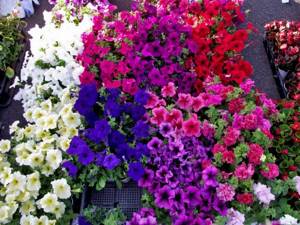
The saturation and variety of shades makes it possible to create amazing compositions even without combination with other plants. Luxurious petunia bushes are a self-sufficient decor for lawns, terraces, country gardens and any areas that take on an elegant look with this design.
Petunia is grown by seedlings. It is not recommended to sow it directly into open soil - flowers rarely sprout in cool soil without proper care, but they feel great in “greenhouse” conditions.
Lobelia
Another famous representative of those ground cover flowers that you can plant in your garden. This compact bush plant will decorate your garden plot throughout the summer.
Despite the fact that the homeland of lobelia is Africa, it is quite cold-resistant and can easily withstand both spring frosts and autumn cold snaps - it will bloom until deep frosts.
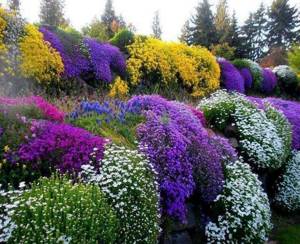
It grows equally well in the sun and in the shade. Loves abundant watering and light, nutritious soil. This flower is a universal decorative element, as its delicate openwork inflorescences go well with any style of garden design.
Tulips
These are not only the most common perennials loved by summer residents, but also the most unpretentious plants to care for. They are just one of those flowers that are not at all difficult to plant in your dacha. Thanks to the efforts of breeders, today flower growers have several hundred varieties and hybrids of this wonderful plant at their disposal.
Not everyone knows that it is correct to plant perennial flowers in the country when the soil temperature drops to +10 degrees. Usually in central Russia this time falls in mid-September.

If you skillfully select varieties, you can decorate the area in a variety of ways with just tulips, starting with an ordinary flower bed and ending with an alpine hill. These flowers simply amaze with their variety of shapes, sizes and shades.
Tulips look most successful in landscape design in groups. It is also customary to plant these plants according to their height, and to prevent the flowerbed from becoming empty quickly, you need to select varieties according to flowering time.



